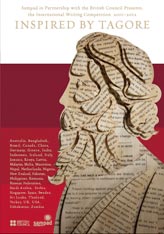As part of its celebrations to mark the 150th anniversary of the birth of Rabindranath Tagore, sampad launched an international writing competition: Inspired by Tagore. My entry ‘Watching Tagore’ was one of the winning entries and will be published in a commemorative book. I’m even more thrilled because I wrote this short piece on my 40th birthday at the Victoria and Albert Museum, whilst watching a photo montage about Tagore's life, and here's a slightly edited version of the winning entry:
Watching Tagore: At the end of the slim, clay-coloured gallery, I reach a television screen that is showing photos of Tagore on a loop. Although taken largely from when he was very much the elder statesman, there is the occasional picture of him as a younger man, and it is these rare pictures that are the most compelling. They show a man with a strong jaw line; a genetic trait that lay hidden behind his coarse, white beard in later years. In some pictures, his hair is cropped short and thick with curls, a reminder that he grew into the sage-like vision in a full length kurta coupled with long, untamed hair. As he gets older his face ages, but his skin never slackens nor loses its sheen. In one shot, he sports a short, dark beard, and wears a tweed-looking suit making him look like a European professor.
As these photos click through his lifecycle, there is one feature that remains a constant: his eyes. They are unwavering in strength and supremely confident. When they stare at the camera, they are the only things you see. When they look into the distance, they are dense with thought. Some photos are grainier and softer in focus than others, which only lends to the intensity of the man, making everything around him almost insignificant in light of his “inner essence.” It’s fitting that a man who liked the human face for its intensity was also the subject of such commanding portraits.
In each of these photos there is nothing about the environment from which he took inspiration, nothing of his workmanship until you rouse yourself from the screen to circle the room. Dotted around the dark walls are paintings new to an English audience. They appear, on reflection, to be about the man himself. Some are mesmerising, fluid and peaceful, others brooding and earthy in tone.
As I reach the wall that separates the gallery from the rest of the museum, I turn once more to the screen at the end of the room. At that moment, a visitor takes a flash photo of the screen and his face is lost in a blistering white star, but his eyes – electric and potent – penetrate nonetheless.


